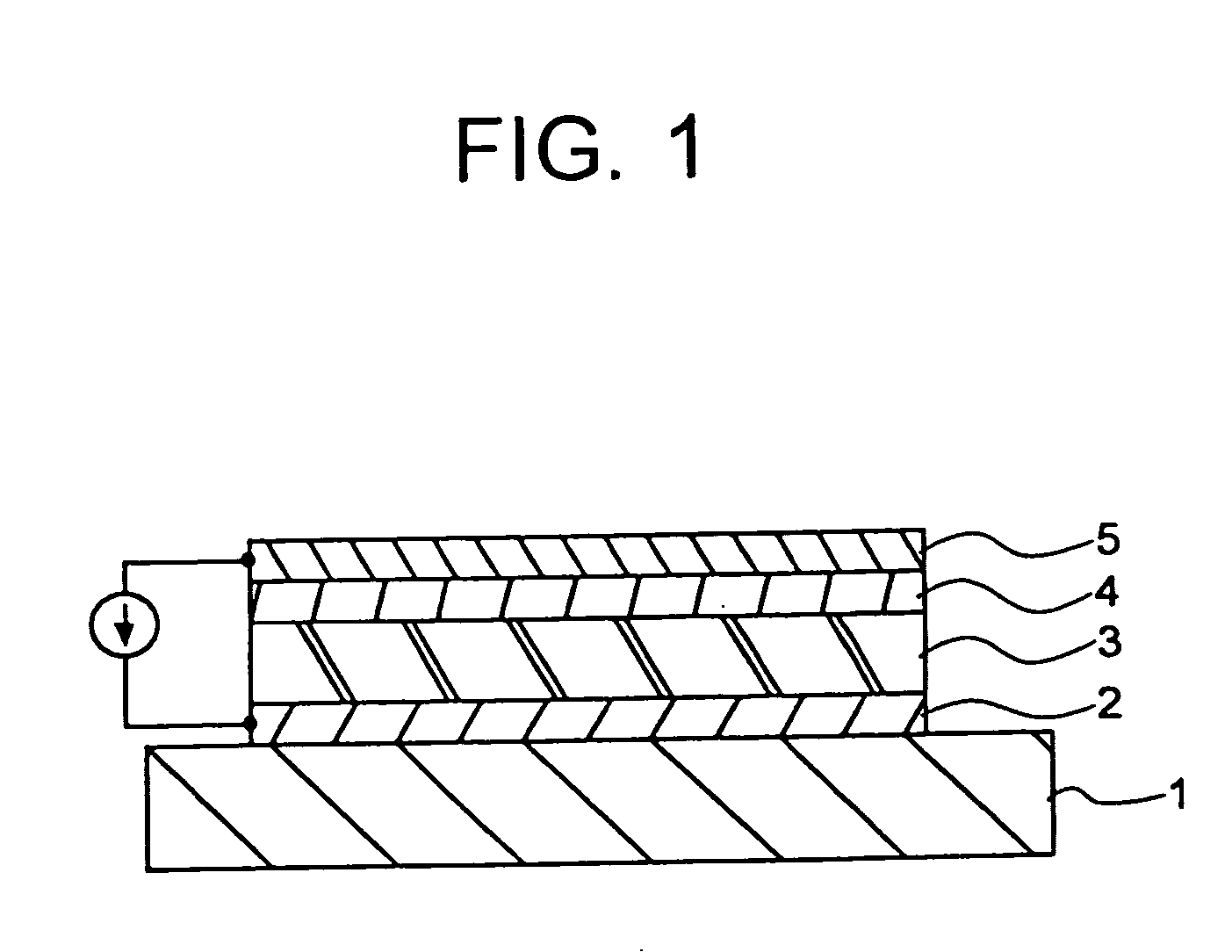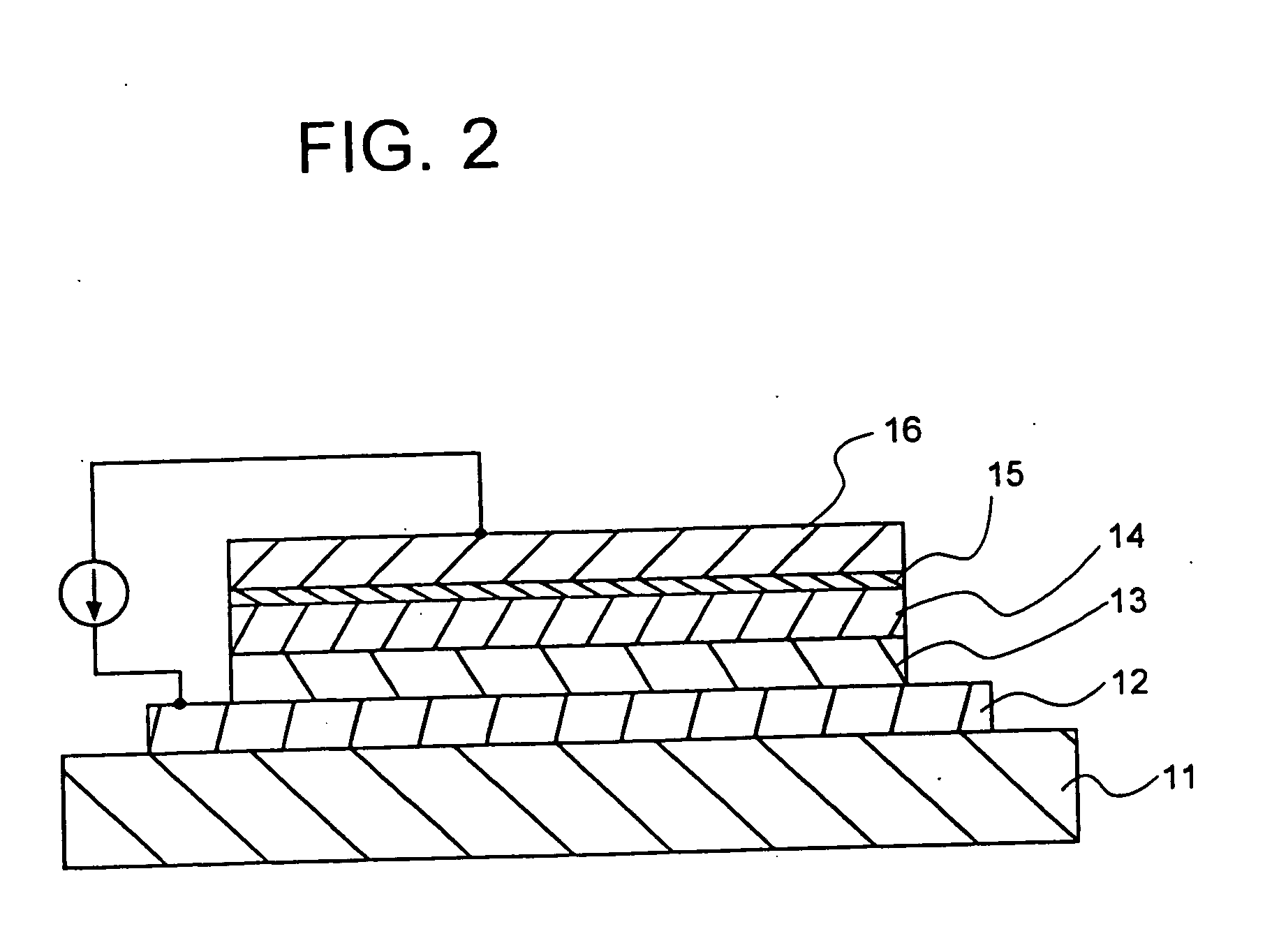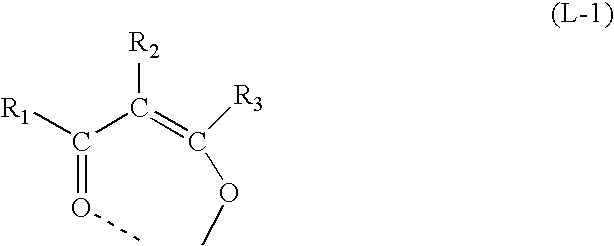Organic EL device and preparation method
a technology of organic el and el foil, which is applied in the direction of discharge tube luminescnet screen, natural mineral layered products, transportation and packaging, etc., can solve the problems of limiting the construction of organic layers which can be formed as laminates, and reducing the efficiency of vacuum evaporation. , to achieve the effect of high efficiency, high reliability and ease of handling
- Summary
- Abstract
- Description
- Claims
- Application Information
AI Technical Summary
Benefits of technology
Problems solved by technology
Method used
Image
Examples
first embodiment
According to the first embodiment of the invention, the organic EL device has an anode 2 on a substrate 1 as shown in FIG. 1. Stacked on the anode 2 are an organic layer 3, typically a light emitting layer, an electron injecting layer 4, and a cathode 5. The organic layer 3 may be a single layer or consist of a plurality of layers. The order of stacking may be reversed. The stack construction may be any appropriate one depending on a particular display specification and manufacture process.
The electron injecting layer 4 close to the cathode 5 is an electron injecting organic layer containing an organic metal salt and / or organic metal complex of a metal having a standard electrode potential of more negative than −1.8 V at 25° C., and formed by coating. In this embodiment, an organic polymer layer containing a high molecular weight EL material is disposed close to the electron injecting organic layer.
The provision of such an electron injecting organic layer ensures a high electro...
embodiment (
ii) Having an Electron Injecting Layer Containing an Inorganic Metal Salt and / or Organic Metal Salt of a Metal Having a Standard Electrode Potential from −1.8 V to −0.8 V at 25° C.
The metals of the inorganic and organic metal salts should have a standard electrode potential at 25° C. between −1.8 V and −0.8 V, and preferably between −1.7 V and −1.15 V. The metals should preferably have a work function of at least 4.0 eV, but generally up to about 6 eV.
Examples of suitable metals include Al (III), Mn (II), Zr (IV), Ti (II), Hf (IV), Ta (V), Nb (III) and V (II). Preferred metals are Al (III), Mn (II) and Zr (IV), with Al (III) and Mn (II) being more preferred. Al (III) is most preferred.
As used herein, the inorganic metal salts include inorganic acids whose hydrogen is substituted with a metal, for example, metal halides such as chlorides, fluorides, bromides and iodides.
The organic metal salts include organic acids, alcohols and dialkylamides whose hydrogen is substituted with...
second embodiment
The organic EL device according to the second embodiment of the invention has, in order, a substrate, a first electrode on the substrate, two or more stacked organic layers on the first electrode including a light emitting layer, and a second electrode on the organic layers. At least one layer of the two or more stacked organic layers other than the light emitting layer contains at least one high or low molecular weight compound selected from among oxadiazole, triazole, thiadiazole, quinoline, quinoxaline, phenanthroline, and derivatives thereof. The light emitting layer contains a π-conjugated polymer, polyvinyl compound, polyacrylate, polymethacrylate or a derivative thereof. These organic layers are formed by coating.
Light emission takes place at a very high efficiency when the light emitting layer contains at least one of π-conjugated polymers, polyvinyl compounds, polyacrylate, polymethacrylate and derivatives thereof, and at least one organic layer other than the light emit...
PUM
| Property | Measurement | Unit |
|---|---|---|
| work function | aaaaa | aaaaa |
| work function | aaaaa | aaaaa |
| standard electrode potential | aaaaa | aaaaa |
Abstract
Description
Claims
Application Information
 Login to View More
Login to View More - R&D
- Intellectual Property
- Life Sciences
- Materials
- Tech Scout
- Unparalleled Data Quality
- Higher Quality Content
- 60% Fewer Hallucinations
Browse by: Latest US Patents, China's latest patents, Technical Efficacy Thesaurus, Application Domain, Technology Topic, Popular Technical Reports.
© 2025 PatSnap. All rights reserved.Legal|Privacy policy|Modern Slavery Act Transparency Statement|Sitemap|About US| Contact US: help@patsnap.com



